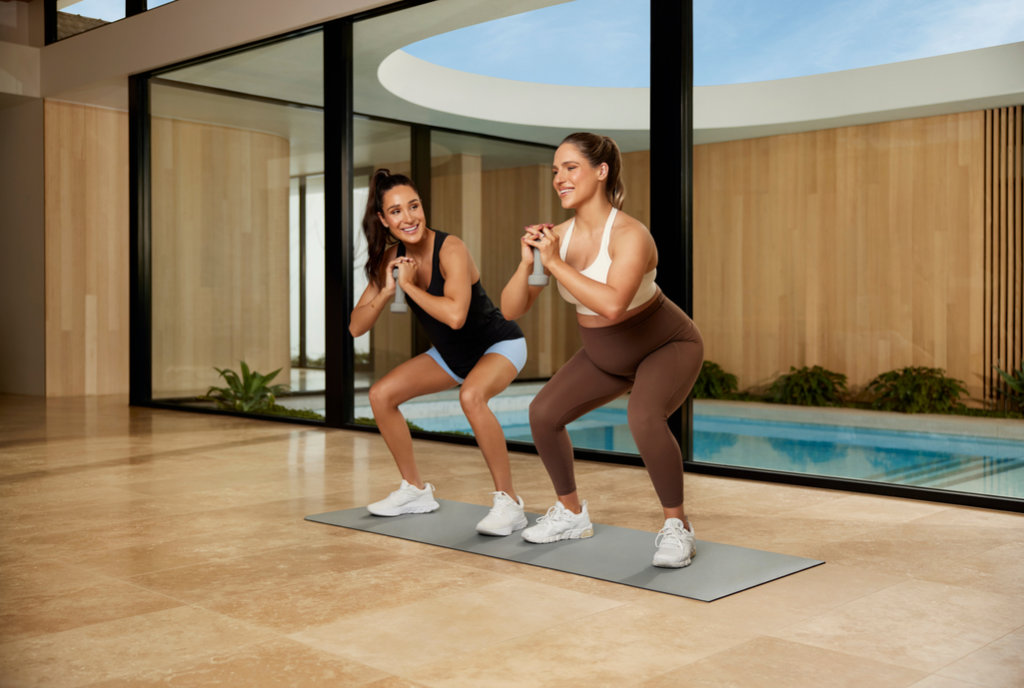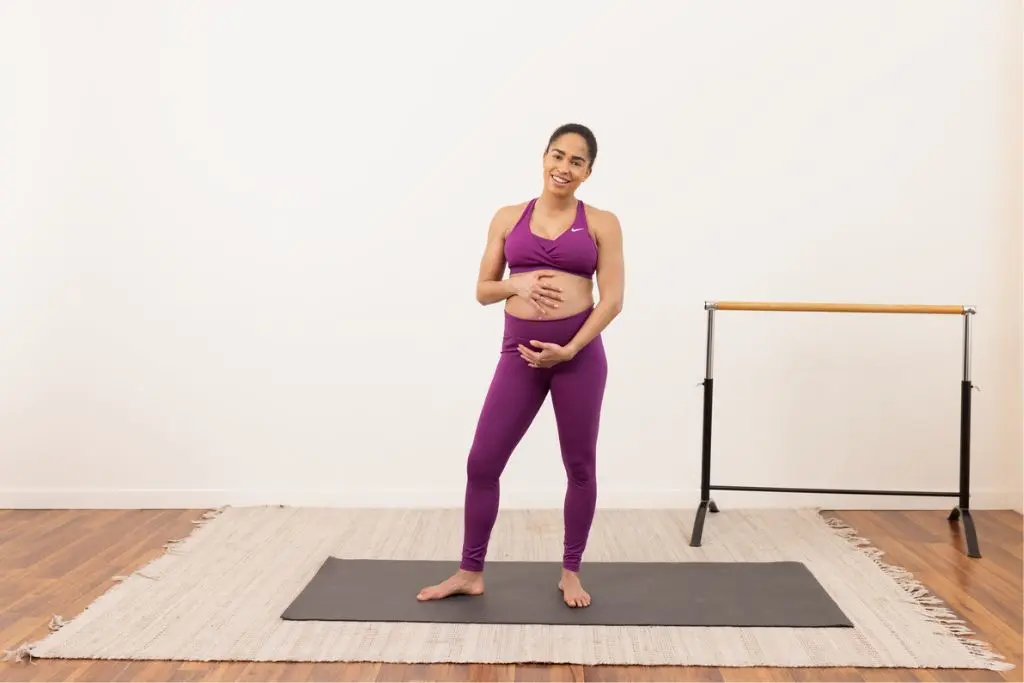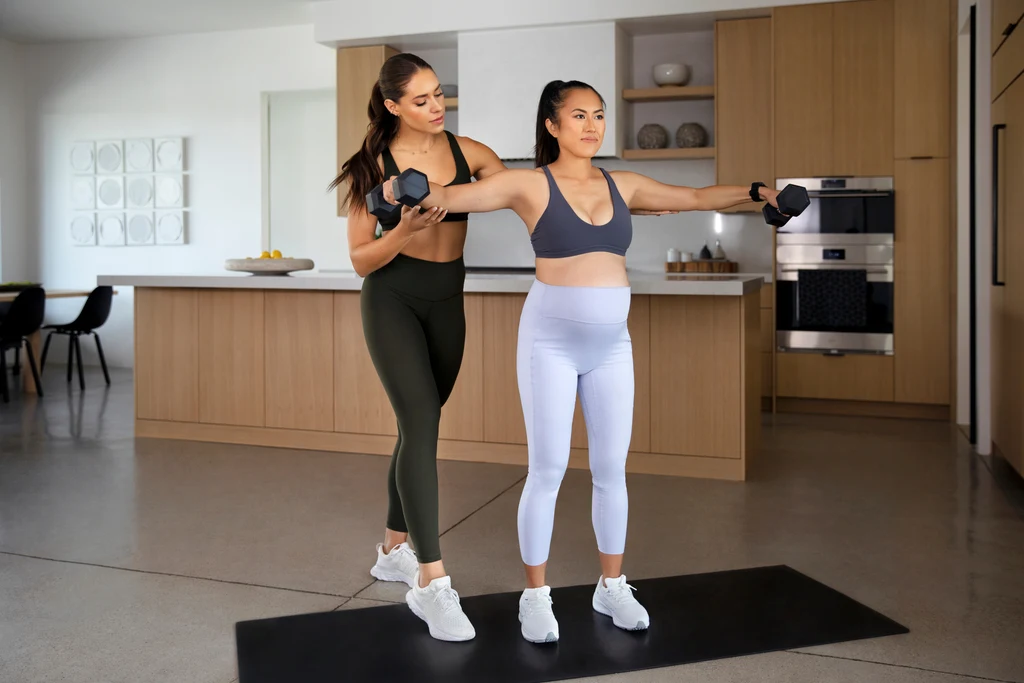Exercise During Pregnancy: Your Questions, Answered

September 13, 2022

Congratulations - you’re expecting! While this is no doubt an exciting time, we also know it can often be incredibly overwhelming and every woman’s experience can be SO different.
Looking for advice on exercising while trying to conceive? Read more here.
Between navigating your changing body, symptoms like fatigue and morning sickness, and the breadth of information that’s out there, it can be hard to know where to start when it comes to approaching physical activity throughout each trimester.
That’s why Sweat’s pregnancy programs from Kayla Itsines, Kelsey Wells and Britany Williams have been designed to help women feel strong and stay active throughout their pregnancy.
Kayla, Kelsey and Brit are not only qualified prenatal trainers, but mums who understand what it’s like to bear witness to the incredible changes your body goes through when you’re expecting. That’s why they want to help you move with confidence - every step of the way.
If you’re looking to continue exercising during your pregnancy, or are wondering if Sweat’s pregnancy programs are the right fit for you, it’s so important to obtain clearance from your healthcare provider before you begin.

Can you exercise when you’re pregnant?
For most women, the answer is yes! However, every woman’s body and pregnancy can be so different, which is why it’s so important to discuss your exercise plans and get clearance from your healthcare provider before you get started.
According to The American College of Obstetricians and Gynaecologists (ACOG), if you’re healthy and your pregnancy is normal, it’s safe to continue or start regular physical activity. The ACOG highlights the importance of discussing your exercise plan with your healthcare provider, cautioning that women with the following pregnancy complications or conditions should not exercise:
Preeclampsia or pregnancy-induced high blood pressure
Placenta previa after 26 weeks of pregnancy. Placenta previa is a condition where the placenta covers the opening of the uterus
Multiple birth pregnancies with risk factors for preterm labour (less than 37 weeks of pregnancy)
Cerclage (this is a procedure where your cervical opening is closed with stitches to prevent or delay preterm birth)
Certain types of heart and lung diseases
Severe anaemia
What are the benefits of exercise during pregnancy?
There are benefits of staying active for both mother and baby, according to the Australian Department of Health. These can include helping your body to prepare for labour and post-birth recovery, lowering your risk of gestational diabetes, lowering your risk of incontinence, reducing back and pelvic pain, and improved mental health, including a decreased risk of postnatal depression.
In addition to these benefits, Mayo Clinic has highlighted that regular exercise can reduce the rates of caesarean births and preeclampsia, while also promoting healthy weight gain and helping to improve your mood, posture, muscle tone, sleep quality, strength and endurance.
How much exercise should you be doing?
Provided both you and your baby are healthy and your healthcare provider has cleared you for exercise, you can generally aim to meet the recommended guidelines for physical activity.
This advice differs slightly from country to country. For example, the CDC and the UK Chief Medical Officers’ guidelines recommend 150 minutes of moderate-intensity activity each week while the Australian Government suggests 2.5-5 hours of moderate-intensity activity and 1.25-2.5 hours of vigorous-intensity activity (or an equivalent combination of the two!).
When deciding how you move your body during pregnancy, it’s also a good idea to take into consideration what your exercise routine looked like before you were expecting. If you weren’t physically active before pregnancy, the advice is to start gradually introducing movement into your routine. If you were very active or following a high-intensity program, you might want to scale it back during this time.
Do you need to take any precautions when exercising?
It’s recommended you drink plenty of water before, during and after your workout to ensure you’re well-hydrated when you’re exercising. If you’re pregnant during the summer, or you live in a warmer climate, it’s also advised you take measures to avoid becoming overheated.
Mayo Clinic also advises that you may need to change your approach to exercise now that you’re pregnant. For example, you should avoid contact sports and activities that increase your fall and collision risk, such as horse riding and basketball.
Throughout your pregnancy, it’s so important to continue listening to your body, and stop exercising and immediately notify your healthcare provider should you experience any worrying symptoms or complications. For example, if you are exercising and experience abdominal pain, bleeding, leaking of amniotic fluid or painful contractions, stop and immediately consult your doctor. You should also keep your healthcare provider updated if you ever experience headaches, chest pain, calf pain or swelling, muscle weakness, severe shortness of breath or dizziness when you’re exercising.

Do you need to follow a pregnancy-specific program?
We know there are so many women in the Sweat Community looking for pregnancy-specific training programs and workouts, which is why we’re thrilled to offer three unique training options: Pregnancy with Kayla, Pregnancy with Kelsey and Pregnancy Barre with Brit.
These pregnancy programs have been designed to help women feel strong during their pregnancy, with low-intensity workouts that are uniquely tailored to each trimester and help you maintain strength, fitness and general health from bump through to birth.
Pregnancy with Kayla and Pregnancy with Kelsey are both 40-week programs designed to empower women to move with confidence from bump through to birth, while Pregnancy Barre with Brit features three weeks of low-intensity workouts per trimester to help you take things at your own pace.
If a structured program doesn’t feel like the right fit for you, that’s fine too! Kayla, Kelsey and Brit want the Sweat Community to know these programs are simply options - there is no pressure and your body knows best. If a program doesn’t feel right for you, any exercise that incorporates cardiovascular fitness will be beneficial, according to Mayo Clinic. Think gentle walks, swimming and modified yoga or Pilates (however, please keep in mind the Pilates and yoga workouts within the Sweat app have not been designed for pregnant women).
Should you change how you approach exercise throughout each trimester?
Sweat's pregnancy programs have been designed with your growing bump in mind, and you will be asked in the Sweat app to select how far along you are before you start your workouts to ensure your place in the program aligns with where you are in your pregnancy.
We know how you’re feeling - inside and out - can change dramatically throughout your pregnancy. Many women feel so unwell during their first trimester that exercise is the last thing on their mind. That’s okay! For every woman that wants to keep moving throughout her pregnancy, there’s a woman who won’t feel up to it.
As your bump grows, certain movements are no longer recommended, which is why it’s so important to start your Sweat program at the right week. For example, while you can lie flat on your back until approximately 20 weeks, after this it’s advised you avoid lying on your back. This recommendation doesn’t just mean apply to exercise - you should stop sleeping on your back, too!
What’s next?
If you’re a new mother who has been cleared to return to exercise after childbirth, Sweat also has two post-pregnancy programs from Kayla and Kelsey available to support you as you rebuild your strength and safely start including exercise in your routine again.
When – and how - you can start exercising again will depend on a range of factors including what kind of birth you had, or any complications you might have experienced during or after your birth. While many women are ready to start exercising again after six weeks, it’s okay if you’re not ready then. Work with your doctor to decide when it’s right for you and your body.
Disclaimer: Although exercise during and after pregnancy has been associated with multiple health benefits, you should consult with and obtain permission from your physician or other health care provider before starting this or any other fitness program to determine if it is right for you, especially while pregnant and in the months following your pregnancy. Not all exercise is suitable for everyone or every pregnancy and exercises, including those contained in this article, may result in injury. Do not start this fitness program if your physician or health care provider advises against it. This article is for informational purposes only. Any instruction, information, or guidance contained in this article is not a substitute for medical advice, consultation, and/or medical treatment from your doctor or healthcare provider. Do not delay seeking medical advice, disregard medical advice, or discontinue medical treatment because of any instruction, information or guidance contained in this article. You are responsible for your own safety and are participating in this fitness activity at your own risk. Start slowly and do not exceed the exercise recommended by your physician or health care provider. If you experience faintness, dizziness, pain, discomfort, bleeding, or shortness of breath at any time while exercising, stop immediately and seek medical advice.

A more empowered you starts with Sweat, and our editorial team is here to bring you the latest fitness tips, trainer recommendations, wellbeing news, nutritional advice, nourishing recipes and free workouts.
* Disclaimer: This blog post is not intended to replace the advice of a medical professional. The above information should not be used to diagnose, treat, or prevent any disease or medical condition. Please consult your doctor before making any changes to your diet, sleep methods, daily activity, or fitness routine. Sweat assumes no responsibility for any personal injury or damage sustained by any recommendations, opinions, or advice given in this article.
Fitness